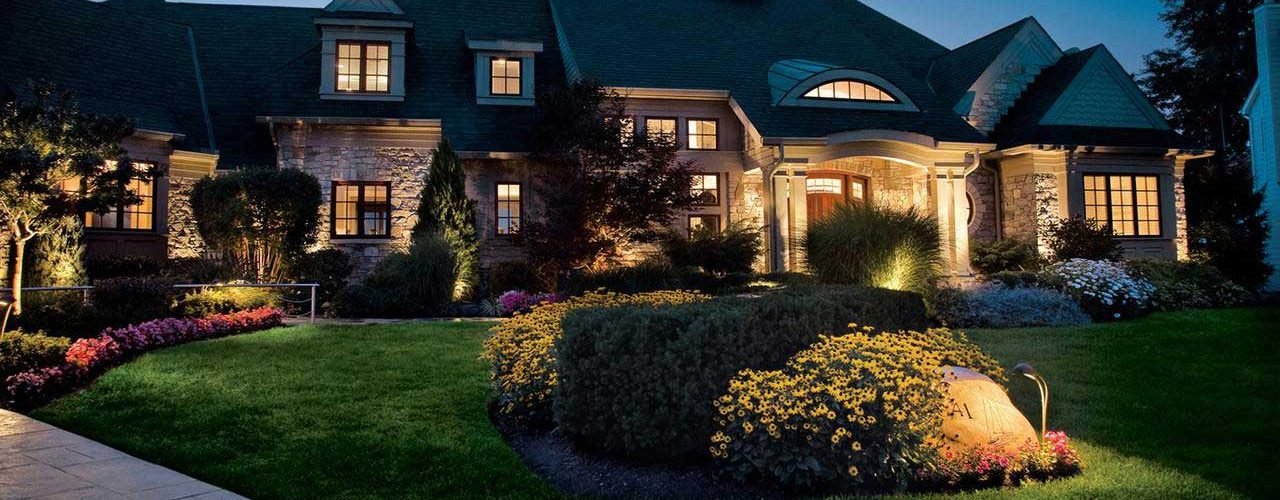Landscape lighting can feel like an intimidating mix of art and science. However, the electronic nature of lights and the art of highlighting key yard features at night doesn’t have to be as hard as many assume.
Today we’ve gathered some of the best landscape lighting tips for those looking to brighten up their nights.
Table of Contents
Tip #1: Have a Goal in Mind
This first tip might also be the most obvious. If you’ve decided you’re going to install some landscape lighting, you should also have a goal for that lighting in mind.
Is your lighting for security? For beautification? These aims are going to involve different positioning of your lights.
That said, there’s also nothing wrong with having a few goals in mind for a given project. If you have a few landscape lighting ideas, it’s probably going to be feasible to at least cover some of them in one project.
There are a wide variety of ways to light up a landscape. None of those ways are wrong (at least if you do them right). The trick is knowing what your goal is before you start buying equipment and digging holes.

Tip #2: Consider Your Blindspots
The odds are good that you don’t want to light up your entire yard with your new lighting project. It’d be hard to do, expensive, and, depending on where you live, there might be complaints.
Instead, you’re going to want to tastefully highlight key elements of your yard. You might also want to make sure certain areas are lit either on a timer or triggered by motion, for both security and convenience purposes.
One important element of lighting for both beautification and security is where you’re not going to have light.
From an artistic perspective, darkness will contrast with areas that are lit. This can be used to your advantage and in some cases can allow for some very striking parts of your landscape to be highlighted with no other visual distraction to draw the eye.
From a security perspective, darkness represents an opportunity for threats to hide. At the very least, key parts of the property like entrances and gates should be guarded by lights that either stay on or will be triggered should someone walk by.
Tip #3: Professionals Can Do Work You Can’t
Unless you’re an electrician and landscaper, the chances are good that your landscape lighting design chops aren’t quite as strong as your ability to imagine what you want.
Done right, there’s nothing wrong with DIY lighting projects. However, done wrong, they can be ugly or even dangerous. In the worst cases, they may represent a fire or electrocution hazard.
One of the best landscape lighting tips we can give in terms of safety is not to bite off more than you can chew. If a project seems like it may be big or complex, hire an outdoor lighting company.
Professionals can help you achieve the result you have in your head, rather than the result you’re capable of getting on your own. They can also offer design help and suggestions if you’re stuck or they notice an issue an amateur might miss.
Outdoor lighting companies can also be great if you know you want lights but aren’t quite sure how best to implement them. You can discuss areas you’d like highlighted and project goals, letting them take the reins on the hard stuff.
Tip #4: Careful Around Water
One of the biggest hazards when performing any kind of electrical work is water. If you’re not prepared, the work can be dangerous in a way not typical of a lot of other landscaping projects.
As you know, water conducts electricity. As you may not know, getting shocked can make it difficult to move, potentially leaving a person stuck in a dangerous situation. If you don’t want tragedy to strike, you need to be careful.
To be clear, this is serious enough that it’s often go-to advice that you should leave electrical lighting work around water to experts. If you’re going to tackle this stuff yourself, do a lot of research and don’t cut any corners.
Messing up, even a little, won’t just endanger the installer. It can also endanger anyone entering the water you’ve installed the lights by.
Tip #5: Brighter Isn’t Always Better
The final tip we’ll leave you with is that brighter is not always the way to go when it comes to choosing the lights you’re installing. While bright lights are good for security, lights for beautification can be all sorts of brightness levels.
If you intend to walk around an area at night, searing bright lights often aren’t what you want. They can hurt the eyes and make it difficult to see anything not in the lit area.
Often a warmer, softer light is a better choice for things like pathing and stair lights. It will make walking around a nicer experience while still providing enough light to see what one is doing.
This isn’t to say bright lights aren’t ever a good option. They can make for an excellent way to highlight flags, which can be difficult to see at night were to use a softer light on account of how high up they can be.
Those Were Our Stellar Landscape Lighting Tips
The benefits of exterior lighting are many; you just need to make sure you do it right! With our landscape lighting tips, we think you’ll be able to do just that.
If you found this article helpful, we have more content for you. Explore our site for articles on home gardening, exciting outdoor adventures, and plenty of other fun topics. There’s something for everyone!





